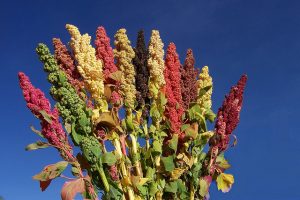Healthy Eating Habits: What Is Quinoa Anyway?
 What makes quinoa (pronounced keen-wah) an amazing food? It contains eight essential amino acids, is high in phosphorus, iron, magnesium, manganese, copper, zinc, vitamins B, and E, and is gluten free.
What makes quinoa (pronounced keen-wah) an amazing food? It contains eight essential amino acids, is high in phosphorus, iron, magnesium, manganese, copper, zinc, vitamins B, and E, and is gluten free.
Though not a grain, quinoa often serves as a rice or grain substitute. Quinoa are the seeds of the Goosefoot plant, which not surprisingly has leaves the shape of geese feet. The oval, flat, pointed seeds are about the size of millet.
Three types of the Goosefoot plant provide seeds for human nourishment. One variety bears red seeds. The pale or white variety is known for its sweet flavor. Black quinoa is the third type.
Preparing and Eating Quinoa
Quinoa seeds are coated with something similar to resin called saponin which has a bitter taste, so the seeds need to be well rinsed before meal preparation. The saponin is quickly washed away when the seeds are rinsed using a strainer. In South America, the saponin from quinoa seeds is used as laundry soap and for its antiseptic quality—not something appetizing to ingest.
When cooked, quinoa has a subtle nut-like flavor and a surprising gentle crunch. The crunch is owed to the germ, or outer part of the seed, which spirals outward like a mini tail during the cooking process.
Quinoa can be:
- dry roasted (in the oven or in a pan)
- made into flour and used in recipes
- sprouted and enjoyed raw in salads and sandwiches
- added to casseroles, salads, or sir-fry (cooked)
- added to soups and stews (uncooked)
- cooked in fruit juice and used to flavor cereal or desserts
- fermented
An Interesting Past, Promising Future
The recorded history of quinoa is a long one. It has been cultivated as food for at least 5,000 years. The seeds were considered sacred by the ancient South American Incas who called quinoa “the mother grain.” Each season at planting time, the Inca ruler planted the first quinoa seed using a solid gold shovel—quite an honor for a tiny seed. Today, quinoa is grown in Bolivia, Chile, Peru, Canada, and the U.S.
Quinoa has a higher fat content than grains. However, our bodies require healthy fats to function properly. These seeds also provide us with fiber but very little sodium, and protein is 12 to 18 percent of each seed’s content. Because of the eight amino acids present, quinoa is considered a complete protein. It is an excellent kitchen staple and nutritious dietary option.
To keep quinoa fresh and edible for six months to a year, refrigerate the seeds in tightly sealed glass jars.
Source: World’s Healthiest Foods
Photo credit Bioversity International / flickr
 Eating Disorder Self Test. Take the EAT-26 self test to see if you might have eating disorder symptoms that might require professional evaluation. All answers are confidential.
Eating Disorder Self Test. Take the EAT-26 self test to see if you might have eating disorder symptoms that might require professional evaluation. All answers are confidential.